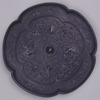- TOP
- Five-lobed Mirror with Auspicious Flowers and Mandarin Ducks
Overview
Five-lobed Mirror with Auspicious Flowers and Mandarin Ducks
- Museum No.
- EK227
Showing 1-6 of 1
| Title | Five-lobed Mirror with Auspicious Flowers and Mandarin Ducks |
|---|---|
| Designation | |
| Artist | |
| Category | Metalwork(E), Bronze Mirrors |
| Country | Japan |
| Period | Heian Late |
| Century | 11th~12th |
| Year | |
| Quantity | |
| Materials | |
| Dimensions | Diameter 10.8cm Rim height 1cm Rim width 0.1cm |
| Inscription by | |
| Signature/Seals Etc | |
| Donor |
This object may be one within a set or the title of a set. To see all objects in the set, perform a Category Search by the Museum Number below, entering numerals only before the hyphen.







This blackish brown bronze mirror has a reflective face plated with tin. The knob is conical in shape, with a chrysanthemum surround. During casting, the sleeve that held the rod used to open the hole in the knob left shallow traces on the knob surround. The narrow rim is straight sided.
The primary motif is that of mandarin ducks, clearly identified by their crests. Some scholars consider the mandarin ducks to be a degeneration of the paired phoenixes motif. There are examples, however, of lacquer ware on which both mandarin ducks and paired phoenixes are depicted on the same object from the latter half of the Heian period (794-1185). One example is the 10th-century makie jewel box decorated with auspicious flowers and arabesques, from the collection of the temple, Ninna-ji, in Kyoto. Mandarin ducks appearing on mirror backs were probably a new version of bird motif. On the other hand, stems of auspicious flowers trailing to the left appeared from an early stage of eight-cusped mirrors, but they appear denser than in the museum mirror.
A typical example of a mirror decorated with mandarin ducks was found in a sutra mound at the Kobe temple, Ishimine-dera, along with a sutra with a postscript that dates it to 1117 (Eikyû 5). The museum example also probably dates from around that time.
Japan-Heian-Late